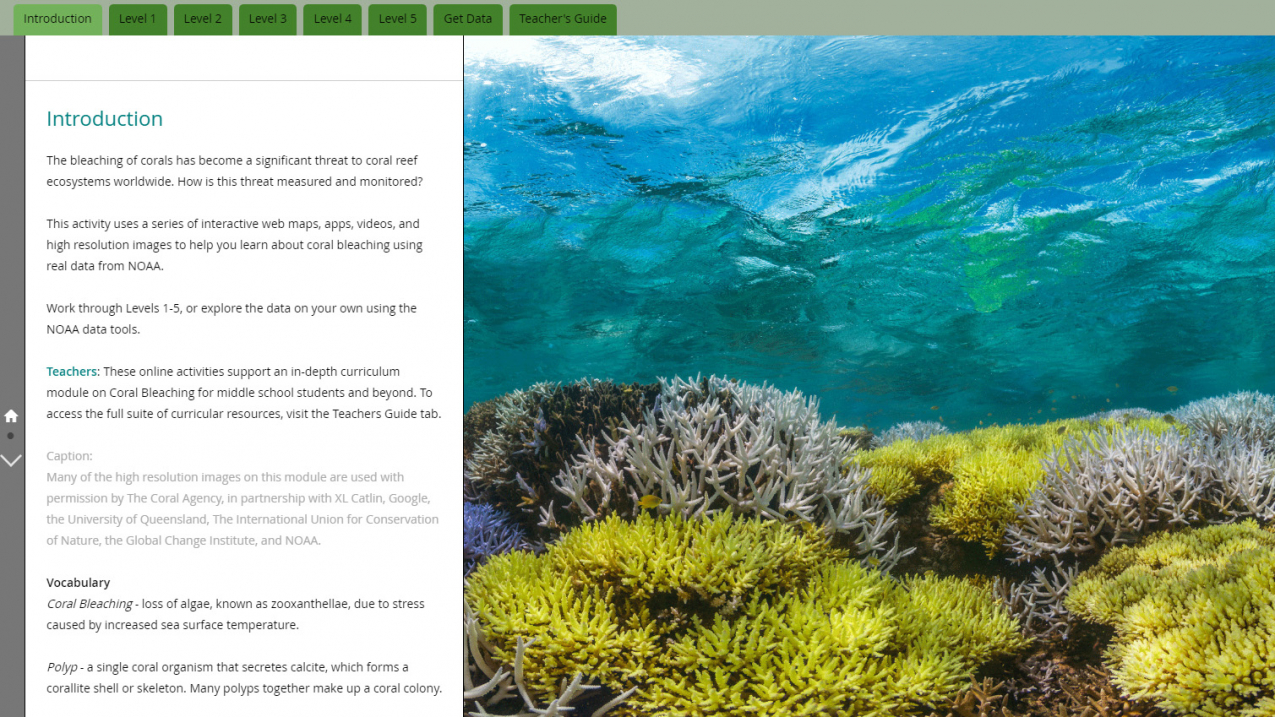Explore NOAA data collected around the globe in formats designed just for educators. These resources take information from our atmosphere and ocean and package it in easily accessible, classroom-friendly lesson plans, activities, and curricula.

A screenshot of the introduction page of the Investigating Coral Bleaching activity, part of Data in the Classroom (Image credit: NOAA Data in the Classroom)
Analyzing ocean tracks offsite link
9th - 12th grade & undergraduate • Teacher guide • Links to standards
Observe the movement of elephant seals, laysan albatross, northern bluefin tuna, and white sharks from the Tagging of Pacific Predators Project (TOPP) in a student-friendly interactive map. This site includes lesson plans and teacher’s guides for high school and undergraduate courses.
Interactive map • Numerical data • Graph/figure
Climate & data ACLIPSE activities offsite link
6th - 12th grade • Teacher guide • Links to standards
This collection uses real-time environmental data in self-directed student activities exploring the natural world. Students learn about carbon cycling, ocean acidification, and other phenomena related to climate change. These modules are designed with a three-dimensional approach to teaching in mind and use a data literacy framework.
Interactive map • Numerical data • Graph/figure
Data in the Classroom
5th - 12th grade • Teacher guide • Links to standards
Data in the Classroom has structured, student-directed lesson plans that use historical and real-time NOAA data. The five modules address research questions and include stepped levels of engagement with complex inquiry investigations with real-time and past data.
Interactive map • Numerical data • Satellite imagery • Graph/figure • Modeled/predicted
Drought data and projections offsite link
9th - 12th grade • Teacher guide • Links to standards
This module includes maps of U.S. drought data (2010–2018) and the world (2013–2018) as well as maps of U.S. drought risk projections until 2095. Students will use these resources to observe seasonal patterns and identify the drought risk for different areas. This activity includes background reading and discussion questions.
Interactive map • Modeled/predicted
Estuaries 101 real-time data system wide monitoring program (SWMP)
6th - 12th grade • Teacher guide • Links to standards
Estuaries 101 helps students and teachers increase their knowledge of coastal and estuarine science and how estuaries affect their daily lives. The curriculum modules in Estuaries 101 feature hands-on learning experiments, field work, interactive maps, and data explorations using data from NOAA’s network of 28 National Estuarine Research Reserves.
Interactive map • Numerical data • Graph/figure
Fishing for information offsite link
9th - 12th grade • Teacher guide • Links to standards
This lesson uses Alaska Groundfish Survey Data from NOAA Fisheries to guide students in developing a research question and understanding the data acquisition process. Students use evidence to draw conclusions.
Interactive map • Numerical data
GLOBE data visualization
K - 12th grade & undergraduate • Teacher guide • Links to standards
View data collected by teachers and students participating in the GLOBE Program and long-term air temperature and precipitation observations from the Global Historical Climate Network (GHCN).
While lessons for data collection and other activities are a part of the GLOBE website, specific lessons for manipulation of this data are not provided at this link.
Interactive map • Numerical data • Graph/figure
Teaching with Great Lakes science offsite link
4th - 12th grade • Teacher guide • Links to standards
Explore lessons, datasets, and inquiry projects designed for educators interested in Great Lakes science. Modules can be mixed and matched. The Great Lakes FieldScope allows students to examine data from rivers and streams, watershed boundaries, political boundaries, elevation, and land cover.
Numerical data • Graph/figure
Watching in 3D
9th - 12th grade • Teacher guide • Links to standards
Students explore specific sea floor discoveries (case studies) using step-by-step tool guides for the Ocean Exploration Digital Atlas (a searchable, interactive expedition data map) and authentic interactive mapping data visualization software.
Interactive map
Water quality testing online module offsite link
3rd - 8th grade • Teacher guide • Links to standards
This online activity uses data from the South Puget Sound waterways to teach the importance of water quality, different water quality parameters we test for, and environmental and human factors that influence water quality. More resources and a teacher guide can be found here offsite link.
Numerical data • Graph/figure

